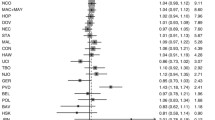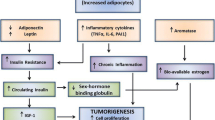Abstract
Objective
To evaluate the effect of obesity on the presentation and course of disease in patients with gynecological cancers.
Study design
Records of patients with endometrial (n = 1180), cervical (n = 738), and ovarian cancer (n = 824) treated between 1986 and 2005 were reviewed. Body mass index (BMI) was analyzed in relation to tumor stage, tumor grading, and prognosis. Steroid hormone receptor status and growth fraction (MIB1; Ki-67-antigen) of tumors in relation to BMI were analyzed in subgroups with endometrial (n = 183) and advanced ovarian (n = 221) cancers. In the latter subgroup, tumor vascularization (CD31) and expression of bcl-2, c-erb-B2, fibronectin, and tumor markers (CA-125, CA15-3, CEA) were also evaluated. Statistical analyses included bivariate correlation, cross-tabulation, Kaplan-Meier-survival analyses, and multifactorial residual survival analyses.
Results
Obese patients with endometrial carcinoma were significantly younger (p < 0.001) and their tumors were less advanced at diagnosis (p = 0.001) and were better differentiated (p = 0.010). In the subgroups, neither steroid hormone receptor status nor MIB1-determined growth fraction correlated with BMI. For both endometrial and cervical carcinomas, a high BMI influenced overall survival favorably (p endometrial = 0.004 and p cervical = 0.026). In ovarian cancer, there was a trend toward improved survival in more obese patients (p = 0.053). Immunohistochemistry revealed that c-erb-B2 expression was slightly lower in tumors of obese patients (r = −0.142; p = 0.039), but BMI did not influence any other factor.
Conclusions
Although obesity increases the incidence of cancer, a high BMI does not seem to adversely influence the prognosis in patients with the mentioned gynecological malignancies.




Similar content being viewed by others
References
Ogden CL, Carroll MD, Curtin LR, McDowell MA, Tabak CJ, Flegal KM (2006) Prevalence of overweight and obesity in the United States, 1999–2004. JAMA 295:1549–1555
Haenle MM, Brockmann SO, Kron M et al (2006) for the EMIL-Study group. Overweight, physical activity, tobacco and alcohol consumption in a cross-sectional random sample of German adults. BMC Public Health 6:233
Douketis JD, Sharma AM (2005) Obesity and cardiovascular disease: pathogenic mechanisms and potential benefits of weight reduction. Semin Vasc Med 5:25–33
Calle EE, Thun MJ (2004) Obesity and cancer. Oncogene 23:6365–6378
Olsen CM, Green AC, Whiteman DC, Sadeghi S, Kolahdooz F, Webb PM (2007) Obesity and the risk of epithelial ovarian cancer: a systematic review and meta-analysis. Eur J Cancer 43:690–709
Bray F, Dos Santos Silva I, Moller H, Weiderpass E (2005) Endometrial cancer incidence trends in Europe: underlying determinants and prospects for prevention. Cancer Epidemiol Biomarkers Prev 14:1132–1142
Wee CC, Phillips RS, McCarthy EP (2005) BMI and cervical cancer screening among white, African-American, and hispanic women in the United States. Obes Res 13:1275–1280
Alexander CI, Liston WA (2006) Operating on the obese woman—a review. BJOG 113:1167–1172
von Gruenigen VE, Tian C, Frasure H, Waggoner S, Keys H, Barakat RR (2006) Treatment effects, disease recurrence, and survival in obese women with early endometrial carcinoma: a Gynecologic Oncology Group study. Cancer 107:2786–2791
Erkanli S, Kayaselcuk F, Bagis T, Kuscu E (2006) Impact of morbid obesity in surgical management of endometrial cancer: surgical morbidity, clinical and pathological aspects. Eur J Gynaecol Oncol 27:401–404
Everett E, Tamimi H, Greer B, Swisher E, Paley P, Mandel L, Goff B (2003) The effect of body mass index on clinical/pathologic features, surgical morbidity, and outcome in patients with endometrial cancer. Gynecol Oncol 90:150–157
McCourt CK, Mutch DG, Gibb RK et al (2007) Body mass index: Relationship to clinical, pathologic and features of microsatellite instability in endometrial cancer. Gynecol Oncol 104:535–539
Temkin SM, Pezzullo JC, Hellmann M, Lee YC, Abulafia O (2007) Is body mass index an independent risk factor of survival among patients with endometrial cancer? Am J Clin Oncol 30:8–14
Münstedt K, von Georgi R, Franke FE (2007) Effect of obesity on survival in epithelial ovarian cancer. Cancer 109:811–812
Pavelka JC, Brown RS, Karlan BY et al (2006) Effect of obesity on survival in epithelial ovarian cancer. Cancer 107:1520–1524
Vahrson H (1991) Die Strahlentherapie des Korpuskarzinoms. In: Künzel W, Kirschbaum M (eds) Giessener Gynäkologische Fortbildung 1991. Springer, Berlin, Heidelberg, New York, pp. 163–179
Brohn S, Kullmer U, Knoblauch B, Adam K, Münstedt K (2004) Prognosefaktoren des Endometriumkarzinoms—Ein Vergleich klinischer und immunhistochemisch bestimmter Parameter. Geburtsh Frauenheilk 64:618–622
Münstedt K, Johnson P, von Georgi R, Vahrson H, Tinneberg H-R (2004) Consequences of inadvertent, suboptimal primary surgery in carcinoma of the uterine cervix. Gynecol Oncol 94:515–520
Münstedt K, Steen J, Knauf AG, Buch T, von Georgi R, Franke FE (2000) Steroid hormone receptors and long term survival in invasive ovarian cancer. Cancer 89:1783–1791
von Georgi R, Franke FE, Münstedt K (2003) The influence of tumorbiology, surgery, and postoperative therapy on patient prognosis in advanced ovarian carcinomas. Eur J Obstet Gynecol Reprod Biol 111:189–196
Franke FE, von Georgi R, Zygmunt M, Münstedt K (2003) Association between fibronectin expression and prognosis in ovarian carcinoma. Anticancer Res 23:4261–4268
Münstedt K, von Georgi R, Franke FE (2004) Correlation between MIB1-determined tumor growth fraction and incidence of tumor recurrence in early ovarian carcinomas. Cancer Invest 22:185–194
Benson K, Hartz AJ (2000) A comparison of observational studies and randomized, controlled trials. N Engl J Med 342:1878–1886
Gates EJ, Hirschfield L, Matthews RP, Yap OW (2006) Body mass index as a prognostic factor in endometrioid adenocarcinoma of the endometrium. J Natl Med Assoc 98:1814–1822
Kjaerbye-Thygesen A, Frederiksen K, Hogdall EV et al (2006) Smoking and overweight: negative prognostic factors in stage III epithelial ovarian cancer. Cancer Epidemiol Biomarkers Prev 15:798–803
Lacey JV Jr, Leitzmann M, Brinton LA et al (2006) Weight, height, and body mass index and risk for ovarian cancer in a cohort study. Ann Epidemiol 16:869–876
Parazzini F, Chiaffarino F, Negri E et al (2004) Risk factors for different histological types of ovarian cancer. Int J Gynecol Cancer 14:431–436
Harlozinska A, Bar JK, Sobanska E, Goluda M (1998) Epidermal growth factor receptor and c-erbB-2 oncoproteins in tissue and tumor effusion cells of histopathologically different ovarian neoplasms. Tumour Biol 19:364–373
Alici S, Kaya S, Izmirli M, Tuncer I, Dogan E, Ozbek H, Sayarlioglu H (2006) Analysis of survival factors in patients with advanced-stage gastric adenocarcinoma. Med Sci Monit 12:CR221–CR229
Lecleire S, Di Fiore F, Antonietti M et al (2006) Undernutrition is predictive of early mortality after palliative self-expanding metal stent insertion in patients with inoperable or recurrent esophageal cancer. Gastrointest Endosc 64:479–484
Parker AS, Lohse CM, Cheville JC, Thiel DD, Leibovich BC, Blute ML (2006) Greater body mass index is associated with better pathologic features and improved outcome among patients treated surgically for clear cell renal cell carcinoma. Urology 68:741–746
Van Cutsem E, Arends J (2005) The causes and consequences of cancer-associated malnutrition. Eur J Oncol Nurs 9(suppl 2):S51–S63
Shang E, Weiss C, Post S, Kaehler G (2006) The influence of early supplementation of parenteral nutrition on quality of life and body composition in patients with advanced cancer. J Parenter Enteral Nutr 30:222–230
Abrahamson PE, Gammon MD, Lund MJ et al (2006) General and abdominal obesity and survival among young women with breast cancer. Cancer Epidemiol Biomarkers Prev 15:1871–1877
Carmichael AR (2006) Obesity and prognosis of breast cancer. Obes Rev 7:333–340
Marret H Perrotin F, Bougnoux P et al (2001) Low body mass index is an independent predictive factor for local recurrence after conservative treatment for breast cancer. Breast Cancer Res Treatment 66:17–23
Ramus SJ, Fishman A, Pharoah PD, Yarkoni S, Altaras M, Ponder BA (2001) Ovarian cancer survival in Ashkenazi Jewish patients with BRCA1 and BRCA2 mutations. Eur J Surg Oncol 27:278–281
Narod SA, Sun P, Ghadirian P et al (2001) Tubal ligation and risk of ovarian cancer in carriers of BRCA1 or BRCA2 mutations: a case-control study. Lancet 357:1467–1470
von Georgi R, Schubert K, Franke FE, Münstedt K (2002) Auswirkungen soziomedizinischer Risikofaktoren auf den Verlauf des Ovarialkarzinoms. Dtsch Med Wochenschr 127:2001–2005
Modan B, Hartge P, Hirsh-Yechezkel G et al (2001) For the National Israel Ovarian Cancer Study Group. Parity, oral contraceptives, and the risk of ovarian cancer among carriers and noncarriers of a BRCA1 or BRCA2 mutation. N Engl J Med 345:235–240
Author information
Authors and Affiliations
Corresponding author
Rights and permissions
About this article
Cite this article
Münstedt, K., Wagner, M., Kullmer, U. et al. Influence of body mass index on prognosis in gynecological malignancies. Cancer Causes Control 19, 909–916 (2008). https://doi.org/10.1007/s10552-008-9152-7
Received:
Accepted:
Published:
Issue Date:
DOI: https://doi.org/10.1007/s10552-008-9152-7




